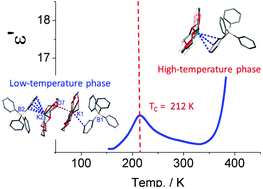An organometallic half-sandwich supramolecular complex {K(18-Crown-6)(ηn-C6H5B(C6H5)3)} (n = 1–6) exhibiting a reversible breaking-symmetry phase transition and switchable dielectric behaviour†
Abstract
A supramolecular crystal, built from a 1 : 1 molar ratio of potassium tetraphenylboron (KBPh4) with 1,4,7,10,13,16-hexaoxacyclooctadecane (18-Crown-6), contains an organometallic half-sandwich superstructure unit {K(18-Crown-6)(ηn-C6H5B(C6H5)3)} (1 with n = 1–6), and shows a reversible phase transition at ∼211 K. The analysis of crystal structures at 173 K in the low-temperature phase, and 293 and 423 K in the high-temperature phase revealed that the breaking-symmetry phase transition is associated with the order–disorder transformation of [K(18-Crown-6)]+ and the change of the coordination mode of the phenyl ring to K+. A dielectric anomaly appears at ca. 212 K and dielectric relaxation occurs above 375 K in 1. The dielectric and thermal anomaly temperatures are close to each other, and the dielectric relaxation is relevant to the relative displacement of [K(18-Crown-6)]+ and the tetraphenylboron anion.



 Please wait while we load your content...
Please wait while we load your content...